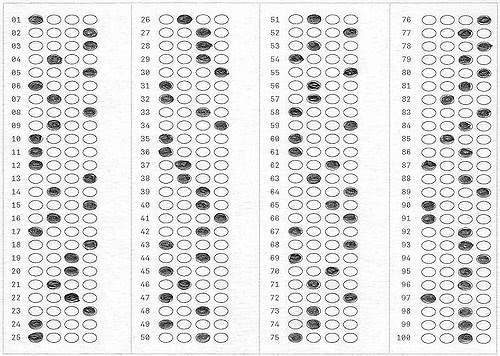Key Takeaways:
- The Preliminary Scholastic Aptitude Test (PSAT), is a test administered by College Board with the participation of the National Merit Scholarship Corporation (NMSC).
- It tests students on reading, writing, and math.
- The PSAT is usually taken by high school students in their junior year.
- Scoring high on the PSAT can qualify students to win the National Merit Scholarship.
While some students see the PSAT as a “practice SAT,” it’s much more important – it actually could result in some money and recognition if you score well enough. This guide covers everything you need to know about the PSAT, why it’s important, common myths, comparisons to other options, and study tips.
What is the PSAT?

Flickr user Illinois Springfield
The PSAT, which stands for Preliminary Scholastic Aptitude Test or Preliminary SAT, is a standardized test offered by the College Board and National Merit Scholarship Corporation. Although it can be a good practice SAT and is often presented as a practice test, students’ scores can result in money and recognition if they qualify for the National Merit Scholarship Qualifying Test (NMSQT).
The PSAT/NMSQT is for juniors, the PSAT 10 is for sophomores, and the PSAT 8/9 is for 8th and 9th graders. Although high school seniors can technically sit for the PSAT, there isn’t really a benefit for doing so and most high schools won’t offer the test for seniors.
Who Should Take the PSAT?
All high school students are invited to take the PSAT, but it’s usually taken in junior year. This is because only juniors can qualify for the NMSQT.
Students can’t individually register for the exam through College Board. Instead, many high schools have a designated “PSAT day” in October. The test has an $18 fee, but schools tend to waive the fee for their students.
What is Tested on the PSAT?
The PSAT made some major changes in 2023. It’s currently 2 hours and 14 minutes long (down from 2 hours and 45 minutes), gives you more time per question, and is completely digital. And instead of having to bring your own approved calculator to the test, the exam comes with a built-in calculator.
A majority of the questions on the PSAT are multiple-choice, but some in the Math section require you to write in your answer. Questions are arranged from easiest to hardest in both sections.
There are two sections on the PSAT, Reading and Writing and Math. Each is scored between 160 and 760. The scores are combined to give you your PSAT score between 320 and 1520.
Reading and Writing
The Reading and Writing Section contains 54 questions and tasks broken up into two modules that take 32 minutes each. The sections quizzes you on your ability to read, comprehend, and utilize the information that is given to you in the supplied texts. The passages cover a number of different subjects including literature, history, social studies, science, and the humanities, and can include graphics.
Students are expected to answer questions on vocabulary, analysis, reasoning, the central ideas of the texts, inferences, English language, grammar, and the expression of ideas.
Math
The Math section is also broken down into 2 modules. Each 35-minute module contains 22 questions (44 total). Students will have to answer questions on algebra, advanced math, problem-solving, data analysis, geometry, and trigonometry.
Why is the PSAT Important?
There are two main reasons why the PSAT is important:
It’s good Practice for the SAT
Although some colleges and universities are doing away with the SAT/ACT requirement, many schools still do require or recommend you submit your standardized test scores. The PSAT is excellent practice for the SAT as it follows a similar format and has the same sort of questions. It will also be proctored just like the SAT, so students can get a feel for time limits and get a better idea of the required testing strategies.
Even though the PSAT doesn’t perfectly line up with the ACT, it’s still good practice for the ACT as there is plenty of overlap. In 2025, the science section of the ACT will be optional, so there will be even fewer differences between the tests.
It Enters You to Win the National Merit Scholarship
The second reason you’ll want to take the PSAT is because it’s also known as the National Merit Scholarship Qualifying Test (NMSQT).
Eligibility requirements include:
- Be enrolled as a high school student as a junior
- Plan to accept college admission in the fall after high school graduation
- Attend high school within the United States, District of Columbia, or U.S. commonwealths and territories OR meet citizenship requirements if attending school outside of the United States
Scoring high enough on the exam can qualify you for some scholarship money and recognition. The NMSC expects that 3.5 million students will take the 2024 PSAT and 1.3 million of them will meet the requirements to enter the scholarship program. However, only the top scorers, typically the top 1%, will actually enter the program.
Each year, around 50,000 students who earned top scores qualify. Out of these roughly 34,000 students will be named Commended Students and receive Letters of Commendation. The remaining 16,000 will be considered Semifinalists and can move onto the next steps, including submitting an application to the NMSC. About 7,000 Semifinalists will be named Finalists or “National Merit Scholars,” which can be a great fact to include on your college applications. Finalists also receive the National Merit Scholarship ($2,500).
A high PSAT score can also qualify you for additional scholarships through private organizations.
PSAT vs. SAT vs. ACT vs. PreACT
Understanding the difference between the practice tests and standardized tests can help you create a strategy and determine where your time will be best spent. Here’s a look at some of the differences between the PSAT, SAT, ACT, and PreACT.
| PSAT | SAT | ACT | PreACT** | |
|---|---|---|---|---|
| Grade requirement | 8th – 12th | All grades | All grades | 8th – 10th |
| Score range | 320 – 1520 | 400 – 1600 | 1 – 36 | 1 – 35 for PreACT 1 – 30 for PreACT 8/9 |
| Length | 2 hrs 14 min | 2 hrs 14 min | 2 hrs 55 min* | 2 hrs 30 min |
| Testing options | Digital | Digital | Digital or paper | Digital or paper |
| Required for college admissions | No | Often | Often | No |
| Subjects | Reading and Writing Math | Reading and Writing Math | English Math Reading Science* Writing (optional) | English Math Reading Science |
* In spring 2025, the ACT will be 2 hours and Science will be optional. As of August 2024, there haven’t been any official announcements regarding PreACT changes.
**There are two PreACT’s available. PreACT 8/9 is for 8th and 9th graders. PreACT is for 10th graders.
How to Prepare for the PSAT
To give yourself a good idea of how you’d do on the SAT and try for a National Merit Scholarship, preparation is key. These are a few tips that could help you score well on the PSAT and give you a head start on studying for the SAT.
Study
One of the most important steps you can take to prepare for the PSAT is to study. This means brushing up on math skills that are required for the exam, reading, and analyzing texts. Many SAT prep tools will work perfectly for PSAT prep, too, so you’ll want to break out study apps for your phone, flashcards, and resources like Khan Academy for Official Digital SAT Prep.
Take Practice PSATs
As with the SAT, taking practice PSATs can prove to be truly beneficial for your score. This helps you get familiar with the content and the format before the real deal, and is likely necessary if you want to score high on the PSAT. Taking the exam in your sophomore year (or freshman year if it’s available) is a good start, but likely isn’t enough.
To get the full benefit of these practice PSATs, be sure to make the experience as real as possible. Set aside the 2 hours and 14 minutes to dedicate to the exam with no distractions. Take the exam as if you’re taking the real PSAT. Once you’ve finished, go over your results. You can see where you need to focus on to improve your results for your next practice exam (and, of course, the real PSAT).
Have a Strategy for Tackling the Questions
Devise a strategy for tackling the questions. You’ll want to focus on the easiest questions to start with. This should be straightforward as the test is designed to feature the easiest questions before the harder ones. If you pace yourself correctly, you should have plenty of time to dedicate to those harder questions, too. This is where those practice PSATs come in handy.
If you do find yourself running out of time or you’re really not sure of the answer, guess. Use the process of elimination and cross out the answers that are obviously wrong so you have a better chance of getting it right. When pressed for time or you’re really unsure which is right or wrong, take a random stab at it. You won’t get penalized for getting an answer wrong on the PSAT (or ACT, SAT, or PreACT), but will if you leave it blank.
PSAT Myths
Here are a few myths about the PSAT you may be hearing (and why they’re not true):
It’s Just a Practice Test
Although the PSAT is technically a ‘preliminary’ SAT test and is often associated with practicing for the SAT, it’s much more than that! It’s required if you want to enter into the running for the National Merit Scholarship.
You Don’t Have to Prepare for the PSAT
While the PSAT might not have the same level of significance as the SAT or ACT in college admissions, preparing for it can significantly impact your performance. Preparation can help you become familiar with the test’s format, content, and pacing, which may lead to improved scores. You can go online and take free PSAT practice tests to help you prepare. The higher your score, the more likely you are to win the scholarship.
If You’re Planning on Taking the ACT, You Don’t Have to Take the PSAT
Even if you’re planning on taking the ACT over the next 12 months, the PSAT can still be helpful. First, you could qualify for that scholarship. Second, although the SAT and ACT are different tests, there is a ton of overlap between the two. Sitting for the PSAT can still help you prepare for the ACT.
Colleges Look at Your PSAT Score
When it comes to college admissions, the focus is primarily on your SAT or ACT scores, not your PSAT score. Most college applications don’t even have a designated space for you to report your PSAT scores. However, if you’re named a Commended Student, Semifinalist, or Finalist, you should put that on your application and colleges will take notice.
Your PSAT Scores Don’t Matter
Your scores absolutely matter for the PSAT for a few reasons. One benefit is the potential award by the National Merit Scholarship Program, but you want to take it seriously even if you don’t qualify for the program. Doing well can also set you up for other potential merit scholarships.
Plus, your PSAT scores give you a starting place to work from. As long as you prepare, you can improve upon that score for the SAT and know what sections need the most attention.
You might look at the PSAT and think “it’s just the school forcing us to practice for the SAT.” However, it’s so much more than that. While it is excellent practice, doing well on the PSAT can result in recognition from the NMSC. It’s important to take it seriously as a good score on the PSAT could turn into a higher score on the SAT and free money.
Want to explore other scholarships you could qualify for with high PSAT or SAT scores? Use our Scholarship Search tool to find awards that fit your achievements right here.





